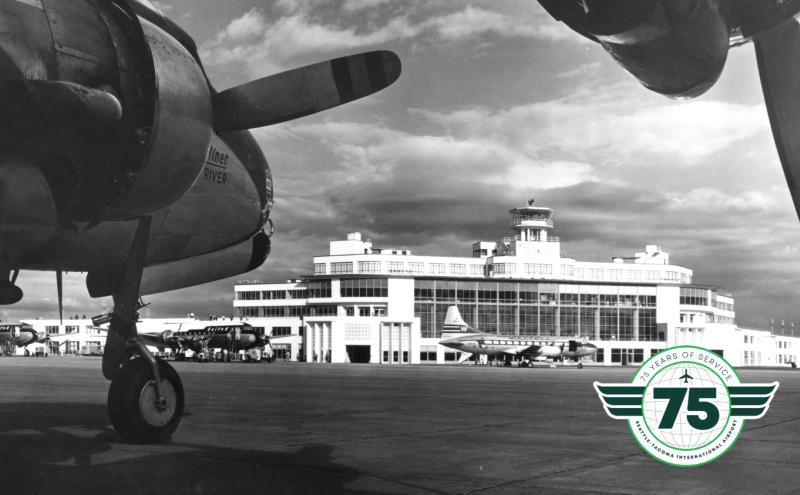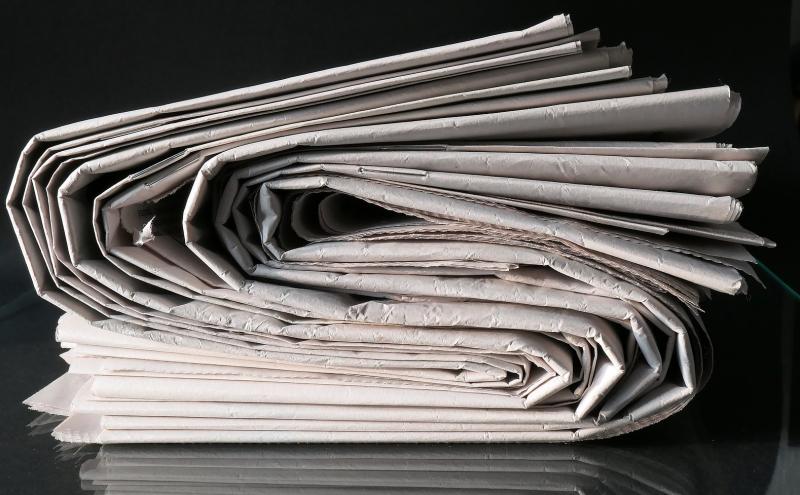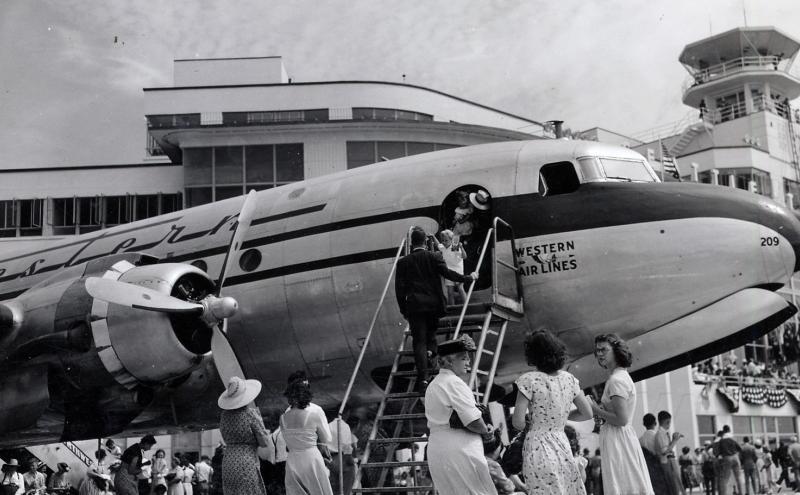
Adapted from “Rising Tides and Tailwinds — The Story of the Port of Seattle” and HistoryLink.org
Before 1941 — Aviation blossoms
Turn of the century
Early Pacific Northwest daredevil pilots and flight enthusiasts used any grassy field or calm body of water to launch and land planes.
1921
The first airport in the region was located at Sand Point on Lake Washington, a site used for Boeing aircraft testing and was later taken over by the Navy.
1925
Federal legislation allowed Boeing Airplane Company to deliver mail for the U.S. Postal Service, and the commercial aviation industry was born.
1928
Boeing Field (aka King County International Airport) became the first commercial airport (and only passenger terminal) in the region on July 26, 1928.
1941-1942 — Building on military roots
The Seattle-Tacoma airport was developed as a direct response to the World War II Pearl Harbor attack in 1941 when military needs limited civilian access to existing airports. Seattle’s Boeing Airplane Company had entered its booming years as part of President Franklin D. Roosevelt’s “arsenal of democracy” by providing thousands of aircraft to the U.S. military — a task that allowed the firm to grow into the largest employer in the region.
Even before Pearl Harbor, increased bomber production clogged Boeing Field, which, although named for the airplane manufacturer, was then King County’s main commercial airport. The growing demands on Boeing Field and the aviation hazards posed by the high ridge to its east, had already prompted calls for a new airport. The same 1941 legislative session that expanded public ports’ ability to issue bonds also specifically authorized ports to build and operate airports.
After the U.S. entered the war and the military took control of Boeing Field, McChord Field in Pierce County, and Paine Field in Snohomish County, the federal Civilian Aviation Authority sought a local government to develop a new regional airport. When the Seattle Chamber of Commerce raised the idea of a major airport in January 1941 and started surveying possible sites in King County, the effort was boosted by the Civil Aeronautics Administration’s (CAA) announcement that $1 million (nearly $22 million in 2023 dollars) could be contributed.
Seattle wasn’t the only city approached. The CAA made similar offers to Tacoma and Vancouver, Washington, though their delayed decisions forfeited the grant money. With Boeing Field operating at a net loss — which it had during the first 14 years of operation – and the Sand Point Naval Station restricted from investing in municipal projects outside Seattle, all eyes turned to the Port, which had property valued at more than $30 million and an annual revenue around $2.5 million in 1941 dollars (roughly $680 million today).
The Port of Seattle promptly stepped forward. Port Commission president Horace Chapman asserted that building the airport “is our duty, and if we can do it, we will.”
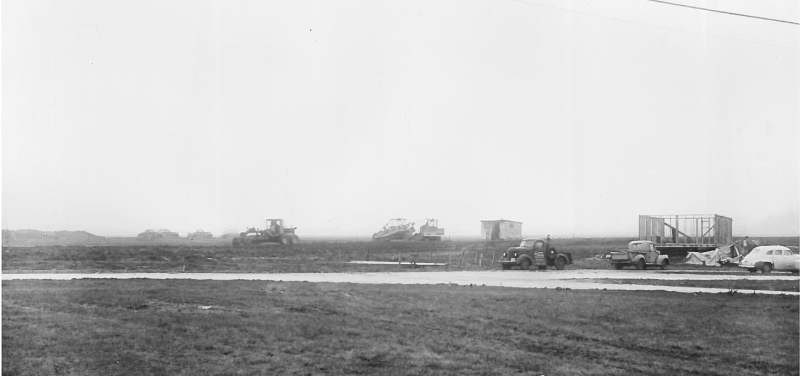
1942-1943 — The search for a site
From the start, transportation was a key factor in determining the location for the new airport. Two sites were considered:
- A rural Eastside location near Lake Sammamish where the Lake Hills neighborhood of Bellevue is today. This spot had the benefit of a lake for seaplanes, which were more common at the time. And there were clear advantages for saving construction time and money.
- The current airport site at Bow Lake between Seattle and Tacoma was picked primarily because of the advantage for passengers and transportation infrastructure. United and Northwest airlines wanted the passenger flow from south Puget Sound and offered a $25,000 advance annually to get the current site completed. Pierce County, the City of Tacoma, and Port of Tacoma offered a combined $100,000 to pick that site because it was 20 miles closer to them compared to the Eastside site — and it helped influence the airport’s name.
When this site was chosen, Port Commission President Horace P. Chapman said that from a commercial standpoint, practically every factor considered favored the current site. It was, the Post-Intelligencer wrote, “the one and only short route terminus from this area for coast to coast, Alaska, and Orient air service.”
The Commission voted March 2, 1942, to build the new field on 907 acres of forest and scrubland at Bow Lake, midway between Seattle and Tacoma. The site selected for SEA Airport initially housed facilities for raising domestic rabbits, a frog patch, a mushroom farm, and a dog kennel.
Seattle’s mayor at the time, William F. Devin, predicted the space was destined to become one of the world’s greats. Seattle Port Commission vice president F.H. Savage agreed. “Seattle, if it goes ahead with the proper steps of development, is now ready to take an important place in world airborne commerce.”
The current airport site brought support from several of the area’s newspaper editorial boards, too: The Seattle Post-Intelligencer, Seattle Times, Daily Olympian, Chehalis Advocate, and the Tacoma News-Tribune.
1943-45 — Airport supports military aviation
January 2, 1943
Dignitaries and Port representatives broke ground near Bow Lake.
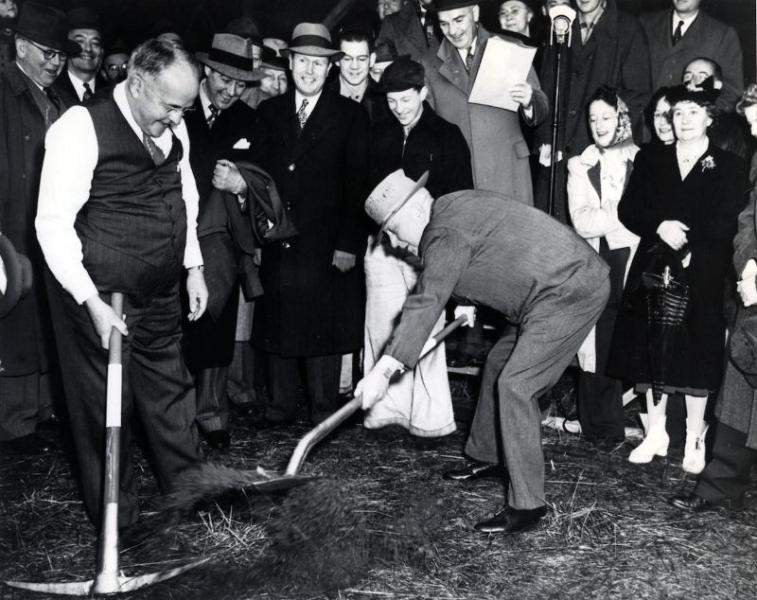
October 31, 1944
Construction of the first runway was completed in 1944. And the ceremonial first landing was by a United Air Lines DC-3.
May 31, 1945
First transcontinental passenger flight from SEA to New York by Northwest Airlines coast to coast in a DC-3 that took 17 hours.
Despite these inaugural events and Pan Am signing the first lease to build an airline terminal and hangar, the airport saw little commercial use until 1946. Instead, the Army Air Force used the new airport for transshipment of thousands of Boeing B-29 bombers.
After the war ended with Japan’s surrender on August 15, 1945, the demand for air travel continued to grow.
1946
Civilian operation began in 1946. When commercial passengers returned to the airport in 1946, terminal facilities consisted of old barracks and a Quonset hut restaurant called “The Pantry,” heated by a potbelly stove.
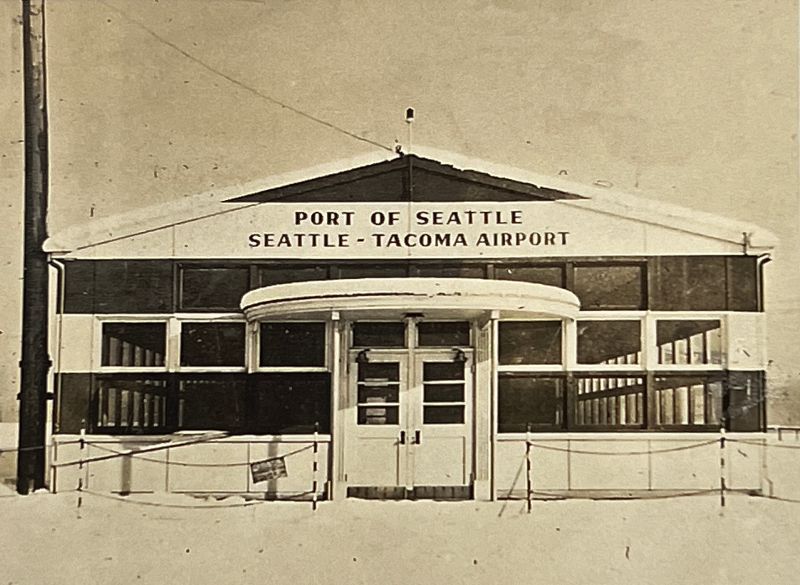
Recognizing that such primitive accommodations would hardly meet the anticipated postwar surge in air travel, the Port commission placed a $3 million bond issue on the November 1946 ballot to fund a new terminal and administration building. The bonds won a sizable majority, but insufficient voter turnout out invalidated the election, forcing the Port to turn to its reserves for funding.
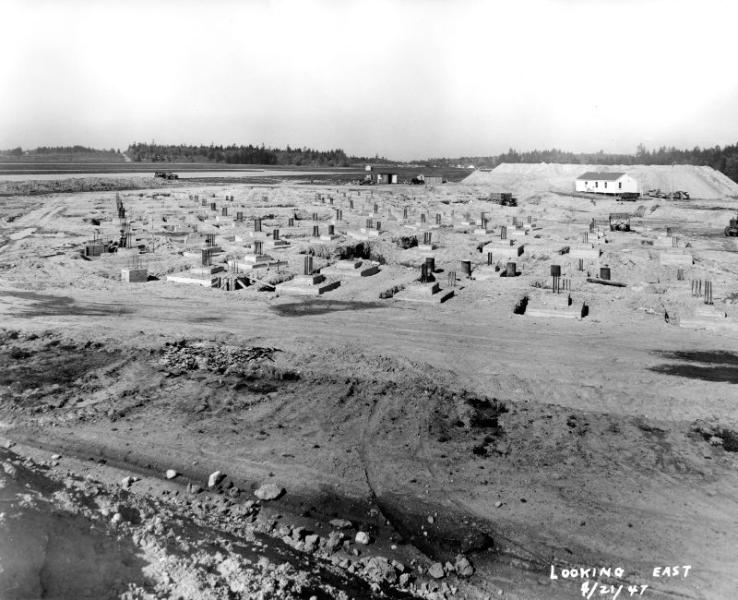
1946-1949 — Birth of the modern airport
1947
Northwest Airlines and Western Airlines inaugurated the new airport’s first scheduled flights on September 1.
October 1947
Colonel Earle S. Bigler, a native Kansan who had headed the Chamber of Commerce’s aviation efforts during World War II, took command of SEA airport for the Port. Bigler coordinated design of the new administration building by Herman A. Moldenhour (1880-1976) and Port of Seattle architects. The building was constructed by Lease-Leighland, while Northwest Airlines built a new hangar to service its new runs to Asia.
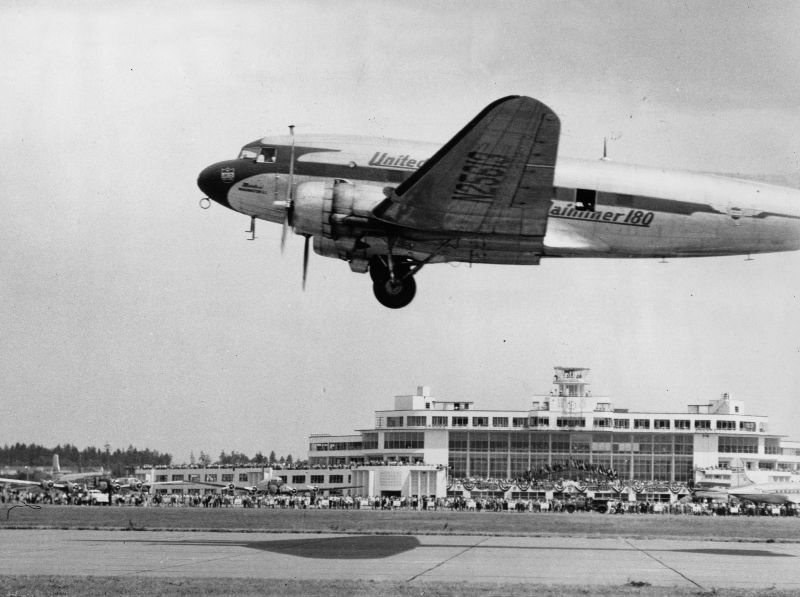
July 9, 1949
Seattle-Tacoma International Airport's (SEA) official dedication drew more than 30,000 people to celebrate the construction of a modern new administration building, passenger terminal, and the official naming ceremony. A four-story, 234,000 square foot office and terminal complex replaced the makeshift World War II-era buildings that first served SEA Airport's first airline passengers.
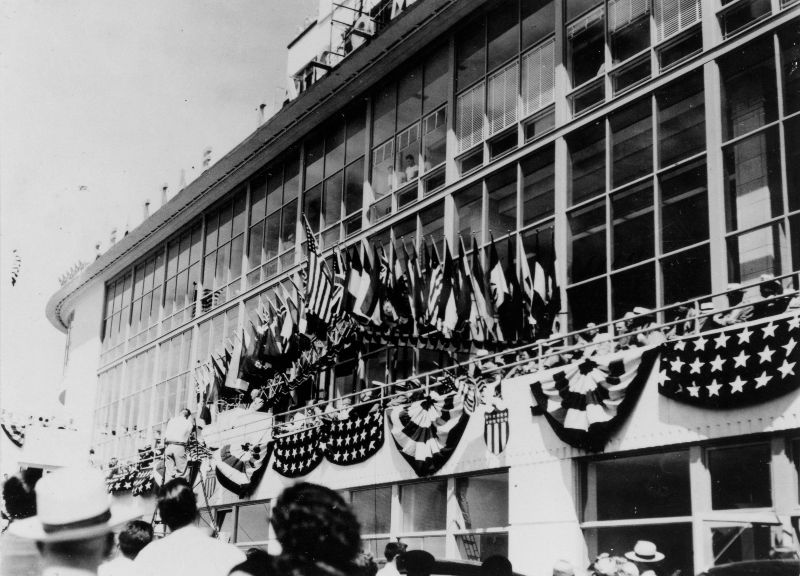
The new passenger terminal offered a vast improvement. At the time, the gleaming white building with its soaring control tower and airy, glass-walled concourses was hailed as America's most advanced airport terminal. The four airlines that served the region shifted their flights from Boeing Field to SEA, which served 1,500 passengers a day on 60 scheduled flights. Inside the terminal, SEA didn’t disappoint. Travelers enjoyed fine dining, a barbershop, gift shop, and a lounge complete with a jazz pianist and singer. The building housed passenger terminals, officers for Port staff, the airlines, a weather bureau, a post office, waiting areas, concourses, an observation deck, gift shops and a coffee shop. Eight airplanes at a time could load and unload at the building.
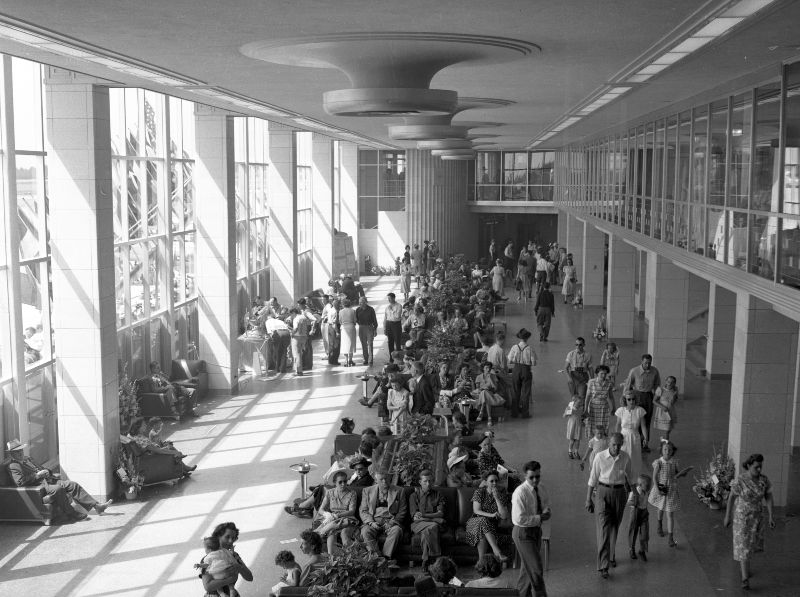
Northwest, United, and Western airlines move the bulk of their services from Boeing Field to SEA Airport in 1949.
Within five months of the dedication, the airport was serving 1,500 passengers per day on 60 scheduled flights.
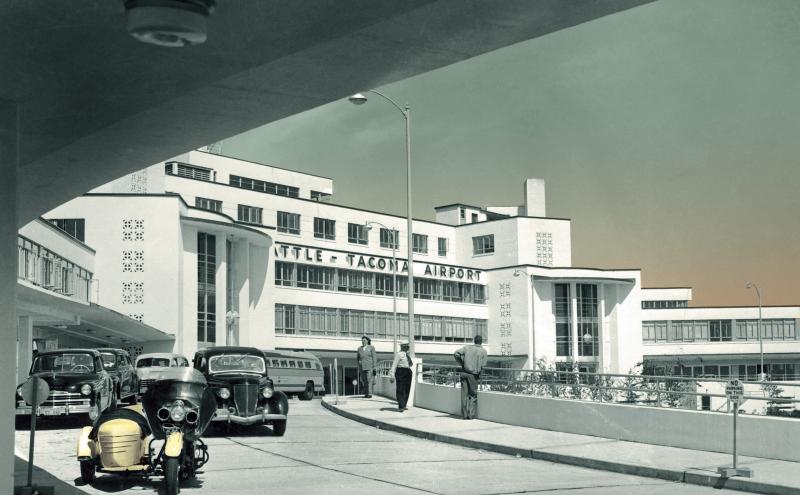
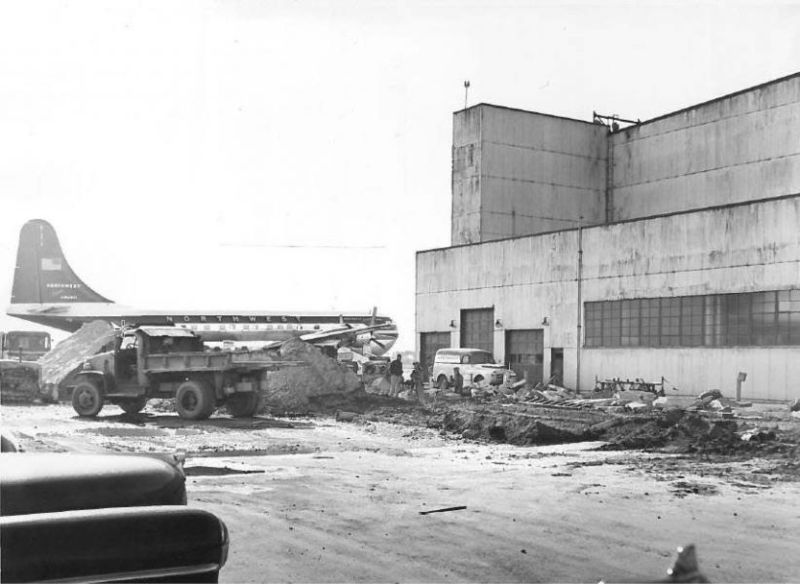
After 1949
The Flying Tiger Line flew commercial air cargo routes through 1988. This image shows a Flying Tiger DC-8 being loaded in the 1970s.
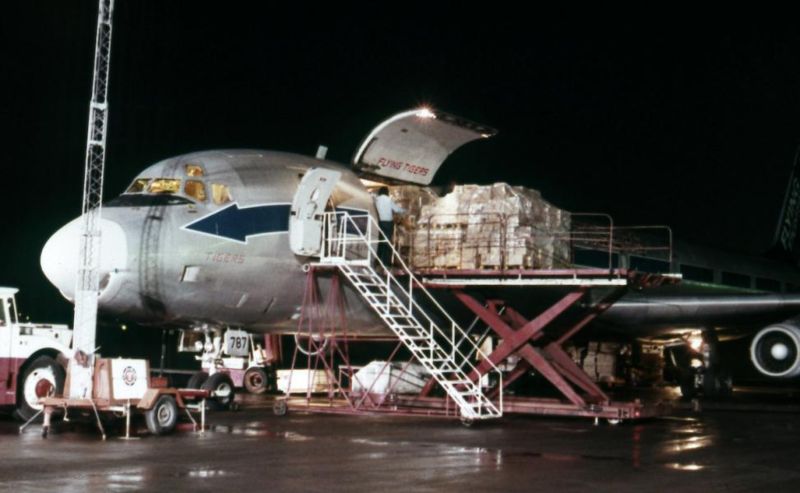
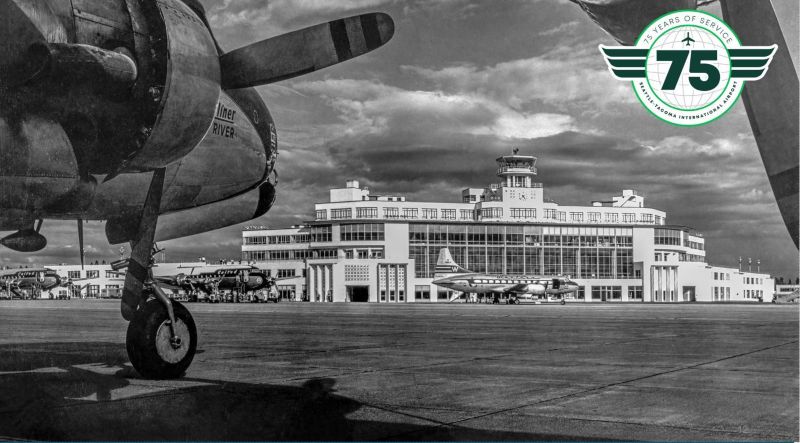
Stay tuned for the next installment on airport history of the 1950s. And check out more SEA Airport history.

